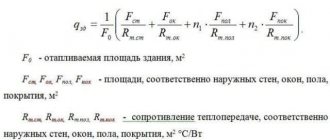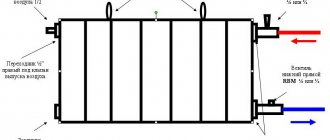Methods for determining load
First, let's explain the meaning of the term. Thermal load is the total amount of heat consumed by the heating system to heat the premises to the standard temperature in the coldest period. The value is calculated in energy units - kilowatts, kilocalories (less often - kilojoules) and is denoted in formulas by the Latin letter Q.
Knowing the heating load of a private house in general and the needs of each room in particular, it is not difficult to select a boiler, heaters and batteries of the water system according to power. How can you calculate this parameter:
- If the ceiling height does not reach 3 m, a larger calculation is made based on the area of heated rooms.
- For ceiling heights of 3 m or more, heat consumption is calculated based on the volume of the premises.
- Determination of heat loss through external fences and the cost of heating ventilation air in accordance with SNiP.
Note. In recent years, online calculators posted on the pages of various Internet resources have gained wide popularity. With their help, determining the amount of thermal energy is carried out quickly and does not require additional instructions. The downside is that the reliability of the results needs to be checked, because the programs are written by people who are not heating engineers.
Photo of the building taken with a thermal imager.
The first two calculation methods are based on the use of specific thermal characteristics in relation to the heated area or volume of the building. The algorithm is simple, used everywhere, but gives very approximate results and does not take into account the degree of insulation of the cottage.
Calculating thermal energy consumption according to SNiP, as design engineers do, is much more difficult. You will have to collect a lot of reference data and work hard on calculations, but the final numbers will reflect the real picture with 95% accuracy. We will try to simplify the methodology and make the calculation of the heating load as easy to understand as possible.
Building regulations
To establish and consolidate standards for heat loss at home, there are codes of practice (SP), norms and regulations (SNiP) used in construction, and GOST:
- SP 131.13330.2012 – on construction climatology;
- SP 50.13330.2010 – on thermal protection of buildings;
- SP 60.13330.2012 – on heating, ventilation and air conditioning in buildings.
- SNiP 2.04.07-86* – on heating networks;
- SNiP 2.08.01-89* – on residential buildings;
- SNiP 2.04.05-91* – on heating, ventilation and air conditioning.
- GOST 22270-76 – on equipment for air conditioning, ventilation and heating;
- GOST 30494-2011 – on microclimate parameters in residential and public buildings;
- GOST 31311-2005 – about heating devices.
The MKD energy passport data must comply with the above technical documentation and be within the regulated standards.
For example, a project for a one-story house of 100 m²
To clearly explain all the methods for determining the amount of thermal energy, we suggest taking as an example a one-story house with a total area of 100 square meters (according to external measurements), shown in the drawing. Let us list the technical characteristics of the building:
- region of construction – temperate climate zone (Minsk, Moscow);
- thickness of external fences – 38 cm, material – sand-lime brick;
- external wall insulation – foam plastic 100 mm thick, density – 25 kg/m³;
- floors – concrete on the ground, no basement;
- ceiling - reinforced concrete slabs, insulated on the cold attic side with 10 cm foam plastic;
- windows – standard metal-plastic with 2 glasses, size – 1500 x 1570 mm (h);
- the entrance door is metal 100 x 200 cm, insulated from the inside with 20 mm extruded polystyrene foam.
The cottage has half-brick (12 cm) interior partitions; the boiler room is located in a separate building. The areas of the rooms are indicated in the drawing, the height of the ceilings will be taken depending on the explained calculation method - 2.8 or 3 m.
We calculate the heat consumption by quadrature
To roughly estimate the heating load, the simplest thermal calculation is usually used: take the outside area of the building and multiply it by 100 W. Accordingly, the heat consumption of a 100 m² country house will be 10,000 W or 10 kW. The result allows you to select a boiler with a safety factor of 1.2-1.3; in this case, the power of the unit is taken to be 12.5 kW.
We propose to perform more accurate calculations that take into account the location of rooms, the number of windows and the region of development. So, for ceiling heights up to 3 m, it is recommended to use the following formula:
The calculation is carried out for each room separately, then the results are summed up and multiplied by the regional coefficient. Explanation of formula symbols:
- Q – required load value, W;
- Spom – square footage of the room, m²;
- q – indicator of specific thermal characteristics, related to the area of the room, W/m²;
- k is a coefficient that takes into account the climate in the area of residence.
For reference. If a private house is located in a temperate climate zone, the coefficient k is taken equal to one. In the southern regions k = 0.7, in the northern regions values of 1.5–2 are used.
In an approximate calculation based on the total quadrature, the indicator q = 100 W/m². This approach does not take into account the location of the rooms and the different number of light openings. The corridor located inside the cottage will lose much less heat than a corner bedroom with windows of the same area. We propose to take the value of the specific thermal characteristic q as follows:
- for rooms with one external wall and a window (or door) q = 100 W/m²;
- corner rooms with one light opening - 120 W/m²;
- the same, with two windows – 130 W/m².
How to correctly select the value of q is clearly shown on the building plan. For our example, the calculation looks like this:
Q = (15.75 x 130 + 21 x 120 + 5 x 100 + 7 x 100 + 6 x 100 + 15.75 x 130 + 21 x 120) x 1 = 10935 W ≈ 11 kW.
As you can see, the refined calculations gave a different result - in fact, 1 kW more thermal energy will be consumed to heat a particular 100 m² house. The figure takes into account the heat consumption to heat the outside air entering the home through openings and walls (infiltration).
Calculation of heat losses in Excel
The process of calculating heat losses at home takes quite a lot of time, so we created a template for ourselves in Excel with which we make calculations. We decided to share it with you and you can use it by following the link. Here we will write out the instructions for use.
Step 1
Follow the link and open the program file. You will see a table like this:
Step 2
You need to fill in the initial data: room number (if you need it), its name and temperature inside, the name of the enclosing structures and their orientation, the dimensions of the structures. You will see that the area counts itself. If you want to subtract the window area from the walls, you need to adjust the formulas, since we do not know where your windows will be recorded. Our space is being taken away. You also need to fill in the heat transfer coefficient 1/R, temperature difference and correction factor. Unfortunately, they are filled out manually. In the example, we have an office with three external walls; one wall has two windows, another has no windows, and the third has one window. The wall structure will be as in the example where we calculated R, eat k=1/R=1/2.64=0.38. Let the floor be on the ground and divide it into zones; we have two of them and calculate the losses for two zones, then k1 = 1/2.15 = 0.47, k2 = 1/4.3 = 0.23. Let the windows be energy-saving Ro = 0.87 (m2°C/W), then k = 1/0.87 = 1.14.
The picture shows that the amount of heat loss is already visible.
Step 3
Unfortunately, additional losses are also filled in manually. You need to enter them as a percentage; the program itself will convert them into a coefficient in the formula. And so, for our example: Walls 3 means +5% heat loss to each wall, the terrain is not spindle therefore +5% to each window and wall, Orientation to the South +5% for structures, to the North and East +10%. There are no external doors, therefore 0, but if there were, the percentages would only be added up to the wall in which there is a door. We remind you that additional heat losses do not apply to the floor or ceiling.
As you can see, the loss of premises has increased. If you already have warm air entering the room, this is the last step. The number written in column Q is your desired heat loss of the room. And this procedure must be carried out for all other premises.
Step 4
In our case, the air is not heated, and in order to calculate the total heat loss, we need to enter the area of our room 18 m2 in column R, and its height 3 m in column S.
This program significantly speeds up and simplifies calculations, even despite the large number of manually entered elements. She helped us more than once. We hope it will become a helper for you too!
Calculation of heat load by room volume
When the distance between the floors and the ceiling reaches 3 m or more, the previous calculation option cannot be used - the result will be incorrect. In such cases, the heating load is usually calculated according to specific aggregated indicators of heat consumption per 1 m³ of room volume.
The formula and calculation algorithm remain the same, only the area parameter S changes to volume – V:
Accordingly, another indicator of specific consumption q is adopted, related to the cubic capacity of each room:
- room inside the building or with one external wall and window – 35 W/m³;
- corner room with one window – 40 W/m³;
- the same, with two light openings - 45 W/m³.
Note. Increasing and decreasing regional coefficients k are applied in the formula without changes.
Now, as an example, let’s determine the heating load of our cottage, taking the ceiling height to be 3 m:
Q = (47.25 x 45 + 63 x 40 + 15 x 35 + 21 x 35 + 18 x 35 + 47.25 x 45 + 63 x 40) x 1 = 11182 W ≈ 11.2 kW.
It is noticeable that the required thermal power of the heating system has increased by 200 W compared to the previous calculation. If we take the height of the rooms to be 2.7-2.8 m and calculate the energy costs per cubic capacity, then the figures will be approximately the same. That is, the method is quite applicable for an aggregated calculation of heat loss in rooms of any height.
Heat loss in a residential building - concept and impact on living conditions
Heat loss is the level of heat lost from a room through walls, windows, ceilings and floors over a certain amount of time. This value is measured in watts per square meter, and depends on the difference between the internal and external air temperatures - the lower it is, the higher the energy efficiency of the building.
The annual difference in natural temperatures is about 60 degrees – from –30° in winter to +30° in summer. A comfortable temperature for a person is considered to be +18/+24°, which must be maintained in residential buildings. This is achieved through building materials (thermal insulating ceilings, walls and floors, energy-saving glass), heating, ventilation or air conditioning systems. Legislatively established building rules, norms and standards that determine the thermal protection of buildings.
How to use the results of calculations
Knowing the building's thermal energy needs, the homeowner can:
- clearly select the power of thermal power equipment for heating the cottage;
- dial the required number of radiator sections;
- determine the required thickness of insulation and perform thermal insulation of the building;
- find out the coolant flow in any part of the system and, if necessary, perform a hydraulic calculation of the pipelines;
- find out the average daily and monthly heat consumption.
The last point is of particular interest. We found the value of the heat load for 1 hour, but it can be recalculated for a longer period and calculate the expected fuel consumption - gas, wood or pellets.
What activities are planned based on the results of heat loss analysis?
If heat leaks are detected, a decision is made to overhaul the building. In order to save energy, external walls are insulated and more powerful and modern heating systems are installed. Better quality windows are installed, with a larger number of double-glazed windows that provide thermal resistance to loss. However, the roof is most often repaired, since it is the most vulnerable place for heat to escape.
If your family, even with “warm floors”, double-glazed windows, a glazed loggia and a modern front door, is freezing, the reason must be sought in leaks of the thermal resource. The calculated data will be the reason for contacting the management company and initiating appropriate actions on its part.











